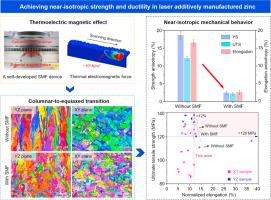Achieving near-isotropic strength and ductility in laser additively manufactured zinc via columnar-to-equiaxed grain transition under thermoelectric magnetic effect
IF 14.3
1区 材料科学
Q1 MATERIALS SCIENCE, MULTIDISCIPLINARY
引用次数: 0
Abstract
This work explored the modulation of grain characteristics in Zn during the laser powder bed fusion (LPBF) process by leveraging the thermoelectric magnetic effect induced by an static magnetic field (SMF) for the first time, aiming to reduce the mechanical anisotropy of the printed Zn material while retaining its excellent ductility at specified strength levels. The solidification behavior in the Zn molten pool during the LPBF process under the influence of thermoelectric magnetic effects was simulated using a physical model that integrated SMF. The results indicated that the thermal electromagnetic force induced by SMF reached up to 106 N/m3, effectively fragmenting regular Zn columnar dendrites and enhancing heterogeneous nucleation efficiency, thus promoting the columnar-to-equiaxed transition and grain refinement. Consequently, compared to samples printed without SMF assistance, the mechanical anisotropy index of yield strength and elongation in the SMF-assisted LPBF-printed Zn sample was significantly reduced from 18.63% and 16.49% to 2.46% and 2.58%, respectively, while maintaining superior strength-ductility synergy. This nearly isotropic mechanical behavior primarily resulted from well-modulated grain characteristics that served as a sustainable source of strength-ductility by coordinating grain boundary strengthening and dislocation strengthening mechanisms, as well as utilizing balanced basal <a> slip and pyramidal <c+a> slip deformation modes. These findings can provide a microstructure manipulation strategy to effectively mitigate the mechanical anisotropy of laser powder bed fusion additively manufactured Zn-based materials for biomedical applications.

热电磁效应下柱状晶向等轴晶转变激光增材制造锌的近各向同性强度和延展性
本文首次利用静磁场(SMF)诱导的热电磁效应,探索了激光粉末床熔合(LPBF)过程中Zn的晶粒特性调制,旨在降低印刷Zn材料的机械各向异性,同时在特定强度水平下保持其优异的延展性。采用集成SMF的物理模型,模拟了热电磁效应影响下LPBF过程中Zn熔池中的凝固行为。结果表明:SMF诱导的热电磁力可达106 N/m3,能有效破碎规则的Zn柱状枝晶,提高非均质形核效率,促进柱状向等轴转变和晶粒细化;结果表明,与没有SMF辅助的样品相比,SMF辅助的lpbf印刷Zn样品的屈服强度和伸长率的力学各向异性指数分别从18.63%和16.49%显著降低到2.46%和2.58%,同时保持了良好的强度-延性协同效应。这种近乎各向同性的力学行为主要是由于调节良好的晶粒特性,通过协调晶界强化和位错强化机制,以及利用平衡的基底滑移和锥体滑移变形模式,作为强度-延性的可持续来源。这些发现可以提供一种微结构操作策略,以有效地减轻激光粉末床熔融增材制造的生物医学用锌基材料的力学各向异性。
本文章由计算机程序翻译,如有差异,请以英文原文为准。
求助全文
约1分钟内获得全文
求助全文
来源期刊

Journal of Materials Science & Technology
工程技术-材料科学:综合
CiteScore
20.00
自引率
11.00%
发文量
995
审稿时长
13 days
期刊介绍:
Journal of Materials Science & Technology strives to promote global collaboration in the field of materials science and technology. It primarily publishes original research papers, invited review articles, letters, research notes, and summaries of scientific achievements. The journal covers a wide range of materials science and technology topics, including metallic materials, inorganic nonmetallic materials, and composite materials.
 求助内容:
求助内容: 应助结果提醒方式:
应助结果提醒方式:


